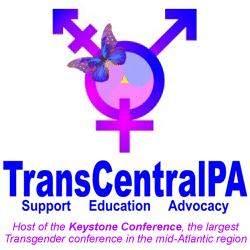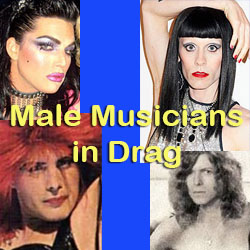How are the Non-Transsexual Transgender People Faring?
With all the attention being paid to adult transsexuals and transgender children, I think that it is time to pay some attention to non-transsexual transgender people. I define a transsexual (TS) as a transgender (TG) person that has modified their body to fit better with society’s expectations of their congruent gender and who usually goes full time in their congruent gender. The statistics tell us that there are at least 10 times more non-transsexual transgender people (non-TS TG) than transsexuals. Estimates of the population frequency of transgender people are converging on 1% and the frequency of MTF transsexual people is about .1% with the frequency of FTM much lower. So where are these non-TS TG people and how are they dealing with part-time expression and secrecy? Since secrecy is psychologically and physically stressful, what can we do to help them bear the load?
I know they (non-TS TG) are out there; I still go to meet-ups and support groups. They frequently attend social meet-ups but seem to becoming increasingly rare in support groups. I will be going to a TG meet-up tonight and have recently been going to contemporary support groups to see what is going on in the community. During the 1970s and 1980s traditional support groups were mainly self-directed by transgender people but today they are more likely to be led by mental health professionals and trained paraprofessionals. The standard traditional support group featured places to dress before the meeting, personal introductions, usually a talk on gender presentation and, later in the evening, going out in public to a nightclub or restaurant. There were strength in numbers at these public outings; so a new TG could feel safe. Today’s social meetups cut right to the chase and just meet in a restaurant where people try to make introductions over the restaurant noise. Some later go to nightclubs as the traditional groups did. But it is hard to get a handle on how non-TS TG’s are doing from these social encounters. There is no time real time for conversation.
Today’s support groups are now increasingly populated with transgender children and their parents who meet to compare notes on such things as hormone blockers and how to beat the drivers license and identification document systems. Because the identification change requirements here in Georgia are unreasonably strict, many children go out of state for name and sex marker changes if they can and/or get a passport before they are old enough to go to our DMV to get their licenses. Sometimes flashing a passport with the right name and sex marker is enough. Another primary issue is to talk about school and school bullying. The prevailing culture here in Georgia does not tolerate or accept transgender people, so students and teachers alike harass TG children. These are important issues but there is not much time left in these groups to support non-TS TGs.
I have considerable experience in being a non-TS TG—about 55 years worth.
It is a lonely and secretive existence. I crossdressed in private at first and then later crossdressed at semi-secret support groups. The fact that I had learned secrecy procedures from the military and intelligence communities, made it a little easier. (I turned my knowledge against these communities because they never discovered that I was transgender.) But secrecy is stressful and corrosive. It demands a high mental workload to keep all the lies straight. It gets in the way of friendships for the same reason. Authenticity is lost, leaving a person unable to express their talents. The mental workload creates negative physiological effects of raising blood pressure, suppressing immune response and other effects. The psychological and physiological stresses can lead to depression and even suicide.
What can we do to help non-TS TG people? First we can provide them with accurate information about being transgender. During my 55 years in the closet, one of the most stressful things to me was the lack of available information. We have lots of information floating around on the Internet about being transgender but a lot of it is inaccurate. That is why I wrote three books which, I believe, accurately convey the facts about transgender science. I can tell you all about the scientific inaccuracies so you can debunk them.
Second, we can support transgender hotlines and online groups to provide resources for TG at wits end. Volunteering and monetary support are good but even spreading the telephone numbers and Internet addresses for suicide hotlines helps. In my latest book, Being Transgender, I have a chapter on coping with transgender issues. Each issue has a section, ordered by the severity of the problem. Because preserving life is paramount, the first section deals with suicide and at the beginning of the section I provide the hotlines and online chat addresses for suicide prevention. The best is the Transgender Lifeline (877-565-8860) and the Trevor Project hotline (866-488-7386). You are supposed to be able to call 911 and be put in touch with the appropriate local suicide hotline. However, sometimes the 911 operators are influenced by culture or not knowledgeable so you may have better results with the national hotlines.
Third, we need to be sure that the healthcare system can provide all TG people with mental health counseling and medical support. Given the proposed cuts in U.S. healthcare this is problematic. Being transgender is a pre-existing condition from birth. Get involved in political action.
Fourth, no transgender person should ever be made to feel inferior by another transgender person because they are not as pretty or handsome or for any other reason. My mother in other contexts used to call this “high-hatting,” and I was brought up to believe that this was ungentlemanly and unethical. I once went to a convention workshop, led by a TS, in which she made fun of transgender people living in secret who kept Public Storage lockers which they used to store clothes and makeup. (Before my current marriage I used to do this.) I got up and walked out but I should have spoken up. If you go to conventions, become an active bystander. Intervene if you witness such high-hatting. Take time to talk to TG people that you otherwise would not. You will learn a few things and feel better about yourself.
Fifth, we need to reach out to non-TS transgender people that we have met but have not kept up with. Once a week, pick out a transgender person on your social media networks that that you have not chatted with for a while and contact them. You may not know whether they are non-TS TG or TS but it does not matter. They will know that someone cares and this will also help bind the community together.
I hope that non-TS TGs read this. I know you are out there and now hopefully my readers are more sensitive to your situation.
Lets hear from you in the comments below. How are you doing?
To comment go here to login.
Category: Transgender Body & Soul, Transgender Opinion











Hi Dana,
Boy have things changed since the early 90s. I joined a crossdressing support group in 1987 (CrossPort in Cincinnati). Back then it was 85% Non-TS TG. Now it is about 90% TS TG.
Now all the ladies who are involved with the group today are quite nice, but I don’t have a lot in common with them. Like you, I still consider myself CD rather than TG and rather enjoy simply being “a guy in a dress”.
To me it seems that the internet was a game changer. Now you can just dress at home and post pictures and have 1200 facebook friends that also like to dress. But FB is not a support group and people need real and tangible friends they can interact with face to face.
For me, it seems the technology allows the TS community to expand but also allows the CD community to retreat father back into the closet.
A very interesting comment. This would argue that the way to reach non-TS TGs is through social media to bring them to local groups.
Spot on, CathyA!
In my experience back in the late 1990s and early 2000s, many crossdressers found it difficult to get out to local meetings, especially with the lighter evenings in summer and the consequent risk of being spotted by neighbours. Certainly the internet changed that, but posting photographs on Facebook is no substitute for face-to-face meetings; while physical meeting spaces may be regarded as merely minor extensions of an individual’s own personal closet, a virtual Facebook group isn’t even this … in fact, one could rightly argue that such groups do nothing at all for a crossdresser’s confidence or personal growth.
But there’s an additional factor which has changed the balance of power in the TG world – namely the politicisation of transsexualism. I believe this has happened because transsexuuals are quite rightly demanding that they should be able to live a full post-op life outside the closet … and crucially – unlike crossdressers – they can’t revert to their natal state if things get awkward or difficult. I’ve never been happy with their usurping of the term “transgender” to describe transsexualism – indeed, this word was originally coined for crossdressers who specifically didn’t intend to transition. I try to avoid labels where I can, but the effect of this has essentially been to rob crossdressers of their identity, and rather than coming out fighting for visibility and rights as I believe they should – and could – have done, they’ve retreated further into the convenient virtual online world. So despite the relative abundance of crossdressers compared to transsexuals in society, all one sees and hears about nowadays is the latter.
If it sounds like I’m little bitter about this outcome, then I suppose I am. I had great hopes that crossdressers would take up the challenge in an exciting world where other minorities were starting to flex their political muscle. Today, the world is rife with with protections (at least on paper) for women, ethnic minorities, the disabled, transsexuals … but crossdressers are still nowhere to be seen. If I libel the average crossdresser, they just accept it – it’s not worth the risk of being “outed” to take me to court.
For example, I delivered a paper at a trans-conference in 2003 entitled “Is That A List Of Crossdressers’ Achievements, Or A Blank Sheet Of Paper?”; it obviously annoyed many of my peers because they complained to the organisers … anonymously, of course. I rest my case! I’d have had far more respect for someone who’d approached me physically and said how offensive my views were, because we could then discuss it. Nowadays, if I were to post that essay online, anyone offended could still comment anonymously if they felt so inclined … or they could simply not read it, delete the link, etc., and pretend the offensive material never happened. (This phenomenon even has a name: a “social media bubble” – see https://tinyurl.com/gotlzye.) Disagreements in a closed environment are unlikely to inspire a Stonewall-type rebellion which grows into a civil-rights movement … which is a shame, because it’s frequently been isolated events in the real world which have provided the spark to ignite global action and drive political change.
But crossdressers’ rights? (Sorry, Dana, but “non-transsexual transgender people’s rights” doesn’t work for me!) A number of opportunities for progress have presented themselves over the past sixty years or so, and they’ve all been lost. Sadly, I see no reason to change my opinion – The Paper Is Still Blank, and is now likely to remain so indefinitely. The closet is far too comfortable.
Actually the word transgender was originally intended to describe transsexuals as those who did not transition because of sexual arousal by John Oliven in 1963. It was originally a psychiatric term. Transgender people repurposed the word and there are many variations of definition. We seem to be doing the same thing now with “gender identity” which originated as a pathological term from Freud, Erikson and Green. The term crossdresser did not start out this way so should be preferred. Unfortunately, no one uses it much anymore, so I did not use it in order to use contemporary, though awkward, terminology. It also has some definitional baggage because some use it to those who crossdress for political protest and in other situations that do not refer to congruent gender.
Graham,
Aren’t we being just a bit cynical about the contributions made by the crossdressing community. You are certainly right that the politicization of transsexualism has changed the balance of power and the high visibility of trans(sitioned) women has created a conservative backlash. The trans revolution will almost always be led by full-time girls, because, yes, we CDs have a different life to lead. Creating unnecessary visibility can harm our home and work relationships to what end. So yes, you may see that as a blank sheet of paper.
That doesn’t mean we don’t contribute to the community as certainly I do through my website, Sister House (www.sisterhouse.net). Let me give you one or two examples.
In the area of relationships, this one article written by a GG/GW has helped CDs improve their spousal relationship. How your Crossdressing changes your wife’s opinion of you (https://www.sisterhouse.net/familyroom/2013/11/10/how-your-crossdressing-changes-your-wifes-opinion-of-you/#post-615)It has been read an amazing 68,000 times.
Terri Lee Ryan’s article, another CD wife, article on 10 Reasons Cross-Dressers’ Wives Divorce Them (https://www.sisterhouse.net/familyroom/2015/04/10/10-reasons-cross-dressers-wives-divorce-them/#post-1106) has been read 45,000 times.
The many articles in the Dressing Room (https://www.sisterhouse.net/dressingroom/) have given trans girls the knowledge and skills to improve their presentation and thus confidence to get out of the closet.
And our Library Transgender Rsources, specifically the articles on All About Crossdressing, All About Transgenderism, and The Wives Speak Out are the most comprehensive on the net for helping the trans and non-trans community understand who we are.
Lastly, I know many non-TS trans girls, myself included, who openly speak at colleges and universities about the trans communities and do Skype sessions with counseling studies to improve their understand and ability to counsel newly-emerging tyrans girls.
So perhaps it’s a blank sheet of paper for you, but not for us.
Wow, you’ve certainly done your homework Dana! I stand corrected. But in my defence, I note that the Wikipedia entry for “transgender” has been updated since I last looked at it … 🙂
I’ve had issues with the term “crossdresser” almost from my first outing “dressed”, as the act invariably entails more than simply “cross”-“dressing” … that’s your “definitional baggage”, I guess. I now prefer the term “female masquerade” to describe traditional crossdressing. I know that many crossdressers don’t like this term, as it conjures up images of drag; many claim that what they do isn’t masquerade, but is very “real” for them. I obviously can’t debate someone else’s internalised viewpoint, however odd I may believe it is. But surely crossdressing is a man simply wearing so-called women’s clothes without the intent to look like a woman? Ergo, the wig and especially the padding have no place in such “pure” crossdressing (whatever that means …)?
Damn. All those double quotes! They’re not very precise definitions!!! That’s the reason – after a long and hard search – I prefer to call myself “gender non-conforming” … there are these strange rules about my gendered behaviour as a man, and I don’t conform to them. It’s nothing to do with sex, and everything to do with expectations and roles. Once one understands the difference between sex and gender, it’s very simple. (Though even that difference is being eroded by meaningless terms such as “gender reassignment”; shame on the professionals for that faux-pas.) So I’m GNC … until someone decides it’s a nice “neutral” term, and changes the definition again. After all, traditional crossdressing could also be categorised as GNC behaviour … could it not?
I finally see where you’re coming from with your “non-transsexual transgender people” … although it’s still too much of a mouthful for me.
Ah – our obsession with labels …
No, I don’t think “we” are being cynical, Tasi. And I think you know exactly what I’m talking about because we’ve discussed the issue of visibility before (and almost got ourselves thrown out of TGF, if I recall!). But OK, if you want my response …
Let’s start with the (single) website you mention. What’s the demographic of the readership? I’d imagine that it’s most likely being accessed by people with some sort of vested interest in trans issues – crossdressers themselves, partners, admirers, maybe transsexuals, etc. … is that right? This would seem to be preaching to the choir! Are there any articles for the “ordinary” reader? For example, are sisterhouse articles cross-published in women’s magazines, men’s health magazines, lifestyle and relationship magazines … that sort of thing?
While I agree that it’s laudable to lecture to college and university students on trans issues, is this not also a captive audience?
But most significantly, where are all the crossdressers making a difference by being out and about? I can’t believe they’re everywhere, but I just haven’t noticed them … given that I know the giveaway signs to look for! Certainly, I see women, blacks, Indians, Sikhs, Muslims, people in wheelchairs, gays both male and female … all the one-time oppressed sectors of society. But I see no crossdressers. That’s the sort of thing I want to see on my sheet of paper – crossdressing and male gender-non-conformance becoming visible.
Fundamentally, when the ORDINARY PUBLIC at large starts regarding crossdressers as regular people rather than freaks (check out some of my recent Facebook material to get a flavour of the current climate), THEN I’ll agree that progress is being made.
Hello Dana,
A timely and well-needed article. I, too, am a NON-TS TG and have been for 67 years. Until age 57, I was in the darkest corner of the closet, only escaping periodically to go to a distant support group or meet a friend and mostly lived a cyber existence. The strain got so intense I plunged, not slipped, into depression. Using the Employee Assistance Program at my work, I surreptitiously found a therapist and began working to save my life. After a year, I could come out to my wife. I was truly on the road to recovery.
I’ve been a victim of Trans*-on-Trans* bigotry, being dressed down by a woman here in town who wanted “nothing to do with you people”. It came as quite a shock. We have since become friends. Coming out later in life, I found little to no information for someone my age. What I learned came from the people I met who, like me, where older and closeted. Those contacts have become my second family and we check in on each other often.
I actively and openly identify as Transgender. I no longer go to support meetings and have built a network of family, friends, associates and acquaintances who only know Cate, and that’s fine with me. I’m active in my community and am out and about freely. I met and came out to a wonder cisgender woman five years ago, first we became friends and last November we became newlyweds.
Dana, I’m happy to report my life has never been better. I look forward to sharing all I can with my sisters and brothers out there too.
Hugs,
Cate O’Malley
I am glad to hear that you are doing well!
There’s also a lot of variety in the “crossdressing” or “Non-TS TG” community as well. It’s a spectrum ranging from people who are perfectly content with occasional dressing in an intimate setting, through all manner of varied mixes of male/female characteristics, to complete transformation.
There’s often an assumption from the world at large that all “crossdressers” ultimately are transsexual, except for social pressure preventing the transformation. That’s simply not true … the spectrum of “trans” is as wide and varied as the spectrum of any other human condition. We aren’t all created the same and that’s what makes it all so interesting IMO 🙂
Diversity is the spice of life and that is what has allowed humans to evolve and prosper. As you say, there are a wide variety of crossdressing expressions. I have been through them all.
“Non-Transsexual Transgender People”? That’s a bit of mouthful, not to mention a labeling nightmare! What’s wrong with the good old-fashioned “crossdresser”?
When I first went to a support group (Crossroads), it was labeled as being a “crossdressing” group. Although nothing had changed about its activities, it became a “transgender” group. I do like the word crossdresser because it is good familiar English instead of those Latin and Greek words that are used to pathologies us.